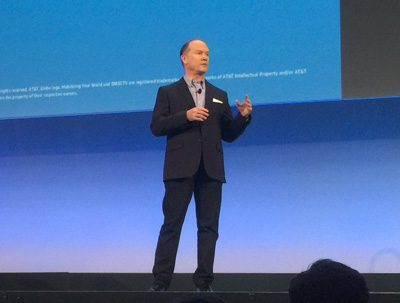AT&T is weeks away from its launch of mobile 5G, said the company’s top wireless executive.
“AT&T is on track to be the first wireless carrier to introduce mobile 5G services in the United States in the next few weeks. This will be standards-based 5G,” said AT&T’s John Donovan, the chief executive of the company’s mobility business, during the company’s quarterly conference call with analysts.
Donovan reiterated AT&T’s previously announced launch plans: The carrier will launch mobile 5G services using the 3GPP’s 5G standard in “parts” of a dozen cities before the end of this year and will expand that launch to additional cities next year. He said the efforts were part of a “drive toward nationwide coverage of our 5G network,” though he did not say when AT&T would offer nationwide 5G services.
Donovan explained that AT&T’s 5G service will leverage work the company has already conducted, including the buildout of its fiber network. "Fiber is the backbone of 5G,” Donovan said, noting that AT&T will pass 18 million customer locations with its fiber network this year, on its way to passing fully 22 million locations with fiber by next year. In locations where AT&T does not own fiber, the company will likely use fiber services of another provider like Zayo.
Further, Donovan said that the operator’s mobile 5G service will sit alongside the company’s existing LTE network, which is also undergoing significant upgrades. AT&T has branded its LTE network upgrades as “5G Evolution,” and Donovan said the upgrades to LTE will be in place in 400 markets by the end of this year and nationwide by the middle of next year. He said those upgrades will support peak LTE speeds of 400 Mbps, in part through the application of LTE LAA technology, which he said would be launched in “parts” of two dozen cities by the end of this year.
AT&T’s 5G launch comes on the heels of Verizon’s recent 5G launch, though the two offerings are dramatically different. Verizon’s 5G launch leverages the company’s proprietary 5GTF network standard, though Verizon has said it will move to the 3GPP’s 5G network standard when equipment for that is available. Further, Verizon’s 5G Home service is intended for fixed applications; meaning, customers can only receive the service via Wi-Fi routers in stationary locations like homes and offices. Verizon launched its 5G service earlier this month in four cities, and said it plans to expand that offering—and will launch mobile 5G services—next year.
AT&T has said that its initial 5G services will work on its 28 GHz spectrum, though it is currently working to refarm other spectrum bands for 5G.
AT&T, for its part, has said that its mobile 5G service will initially be accessible only through a “puck” device at first. Although AT&T hasn’t officially announced that gadget, it will likely be a battery-powered device about the size of a hockey puck that users will be able to take with them to access 5G; users will likely be able to connect their laptops, tablets, phones and others devices to the 5G puck through Wi-Fi.
AT&T and Verizon are not the only ones racing toward 5G launches. T-Mobile has said that it will install—but not necessarily activate—mobile 5G services in 30 cities this year. And Sprint has promised a nationwide 5G launch by next year.

